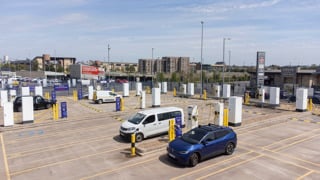Growing concern at the ‘dieselisation’ of the UK car parc could pave the way for ultra-low emission zones being introduced across the country.
London is leading the way and expects to have the world’s first ultra-low emission zone (ULEZ) in place by 2020. A consultation will be launched later this year before final plans are published in 2015.
Vehicle owners, including fleets, would then have five years to ensure any vehicle being driven in the capital complied with the new rules or face the prospect of a large fine.
The key ULEZ entry requirement is expected to be linked to the new Euro6 emissions standard, which more than halves the amount of mono-nitrogen oxides (NOx) a diesel car can emit, with a cap of 80mg/km.
Euro6 becomes mandatory for some new vehicles from September, while compliant cars and light commercial vehicles are already available from some manufacturers.
It is this combination of ULEZs and Euro6 that will be used to curb NOx, along with other harmful emissions such as particulate matter, rather than taxation.
A suggestion from Renault UK’s managing director Ken Ramirez that the current CO2-based regime could be overhauled to instead focus on NOx has been dismissed by the Government.
In the Budget, the chancellor outlined company car benefit-in-kind tax rates up to April 5, 2019, “to provide tax certainty for car manufacturers and company car employers and employees”. He has already ruled out any change to the structure of Vehicle Excise Duty in the current Parliament.
HM Revenue and Customs (HMRC) told Fleet News that vehicle taxation based on CO2 was here to stay for the foreseeable future. “There are no plans to change the underlying structure of car tax legislation,” stressed the spokesman.
The ‘dieselisation’ of the UK car parc has been fuelled by fleets in pursuit of tax savings, as well as fuel consumption benefits. Figures from the Society of Motor Manufacturers and Traders show that sales of new diesel cars accounted for just 14% of all new registrations in 2000, but petrol and diesel model demand is split virtually 50:50 today.
However, while diesels typically have lower CO2 emissions than petrol-engined cars, they are worse for NOx, which can cause lung cancer and major respiratory problems.
Dangerously high levels have resulted in the Highways Agency proposing a 60mph speed limit on a 32-mile stretch of the M1 between Mansfield and Sheffield and Rotherham, and a three-mile section of the M3 from Lightwater to near Farnborough (Fleet News, January 23).
However, that came too late for the European Commission, which launched legal proceedings against the UK Government in February. It is the first of the European Union’s 28 member states to receive notice of enforcement action on NOx and now has until April 20 to respond or face legal proceedings and potentially a fine of up to £300 million.
The areas affected are Greater London, the West Midlands, Greater Manchester, West Yorkshire, Teesside, the Potteries, Hull, Southampton, Glasgow, the East, the South East, the East Midlands, Merseyside, Yorkshire and Humberside, the West Midlands and the North East.
Some towns and cities have attempted to tackle the problem.
Greater London has been the subject of a Low Emission Zone (LEZ) since February 4, 2008, while Norwich has had a small LEZ affecting buses since July 2008. A bus-related LEZ was introduced in Oxford City Centre in January 2014.
A number of other cities are also currently considering similar zones to improve air quality.



















Login to comment
Comments
No comments have been made yet.